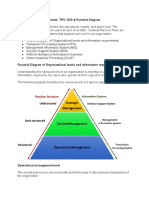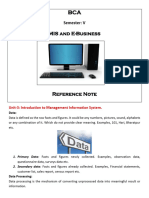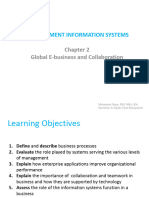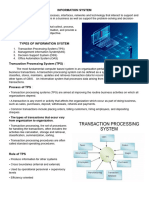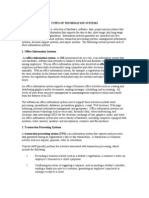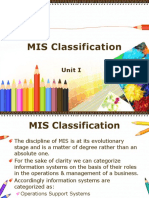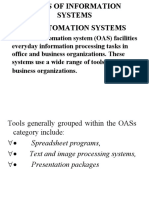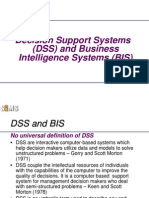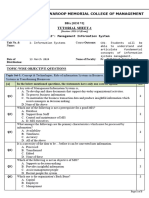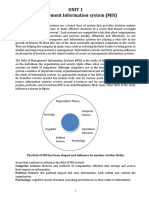DEPARTMENT OF BUSINESS ADMINISTRATION AND ENTREPRENEURSHIP
BAYERO UNIVERSITY, KANO
MGT 8207: MANAGEMENT INFORMATION SYSTEM
SEMESTER, 2021 / 2022 SESSION
Facilitator: Dr. Muktar M. Daneji
Assignment Question
Information System Categories (Enterprise Applications)
Transaction Support System (TSS)
Management information system (MIS)
Decision Support System (DSS)
Executive Support System (ESS)
By
Abubakar Umar Adam
SPS/20/MMN/00001
1
�1.0 INTRODUCTION
Information is considered, without any doubt, a main and foundational element in managerial
decision making in all organizations, due to current challenges in this century. The concept of
information system has received an observable and increased attention in different fields of
modern human life whether on the individual or organization level. Information is a major
resource for the organization and an important source of its success. It is also a factor in
increasing the efficiency and effectiveness of the various administrative activities. This has made
information systems in the various organizations particularly important, helping organizations to
perform their functions successfully and efficiently. The organization needs information so that it
can connect its different parts to achieve its objectives as well as it can successfully adapt to the
surrounding environment. Information is valuable whenever it is of greater use in managerial
decision-making and operations. The changes in the various environmental factors, the growth
and the development that took place in the economic organizations, and the complexity of the
problems they faced, increased the need for the means of collecting and processing the enormous
data, which was difficult to deal with by traditional means. This was made easy due to the
modern technological revolution that led to means that have facilitated and accelerated the
processing of those data and their timely delivery to decision-making centers.
The process of managerial decision-making depends mainly on the information system used to
gather and process information in a scientific manner. The more reliable and timely the
information is, the more correct and beneficial the decision is. Consequently there should be an
integrated information system that provides the organization with the current and future data
helping in correct managerial decision making.
2.0 Systems for Different Management Groups
2
�A business firm has systems to support different groups or levels of management. These systems
include transaction processing systems, management information systems, decision-support
systems, and systems for business intelligence.
2.1 Transaction Processing Systems
Operational managers need systems that keep track of the elementary activities and transactions
of the organization, such as sales, receipts, cash deposits, payroll, credit decisions, and the flow
of materials in a factory. Transaction processing systems (TPS) provide this kind of information.
A transaction processing system is a computerized system that performs and records the daily
routine transactions necessary to conduct business, such as sales order entry, hotel reservations,
payroll, employee record keeping, and shipping (Laudon & Laudon, 2012). TPS or transaction
processing system is a type of information system that collects, stores, modifies and retrieves the
data transaction of an enterprise (Rehman, 2023). According to Rahmatian, (2003) a Transaction
Processing System (TPS) is a system that captures, enters, stores, retrieves, and processes the
relevant details of business events and generates the information and documents necessary for
running the business
2.1.1 Components of the Transaction Processing System (TPS)
1 An input
An input is an original request for a product or payment that an outside party sends to a
company’s TPS. If your company uses batch processing, its TPS stores groups of inputs and then
processes them at a later time. In comparison, if your company uses a real-time system, it
processes each input as it arrives. Inputs typically include: Invoices, Bills, Coupons, Custom
orders.
2. Processing system
3
�The processing system reads each input and creates a useful output, such as a receipt. This
element can help you define the input data and what the output should be. Based on the kind of
TPS your company is using, processing times can vary.
3. Storage
The storage component of TPS refers to where a company keeps its input and output data. Some
companies store these documents in a database. The storage component ensures the organization,
security and accessibility of every document for later use.
For example, if a vendor would like to confirm that your company has paid an invoice, you can
check your system’s storage to find the invoice and determine if you delivered a payment.
4. Outputs
TPS outputs are documents the system generates once it completes processing all inputs, such as
receipts the company stores in its records. These documents can help validate a sale or
transaction and provide important reference information for tax and other official purposes.
2.1.2 Types of the Transaction Processing System (TPS)
According to Amin,et al.,(2012) there are two types of transaction processing systems: Batch and
Real or Online Transaction Processing System (OTPS).
Batch Processing System
A transaction that is done in a batch or group is known as a batch processing system. The batch
processing is not done immediately. First, the data is collected and then placed in a group or
batch then the processing is started. Examples of batch processing systems are:-Credit card
transaction, Payment by cheque
Online Transaction Processing System (Real-Time Processing)
4
�A transaction that is done immediately without any delay is known as an online transaction
processing system (OLTP). It is also known as a real-time transaction. Examples of OLTP are:-
Use card for payment, online transaction
2.2 Management Information Systems (MIS)
The term management information systems (MIS) designates a specific category of information
systems serving middle management. MIS provide middle managers with reports on the
organization’s current performance. This information is used to monitor and control the business
and predict future performance.
MIS is define as type of information systems that transform data to information and
summarized the information to Meaningful and useful forms as management reports to use
it in managerial decision making (Al-Mamary et al., 2013) .
MIS summarize and report on the company’s basic operations using data supplied by transaction
processing systems. The basic transaction data from TPS are compressed and usually presented
in reports that are produced on a regular schedule. MIS Provide information in the form of pre
specified reports and displays to support business decision making (Al-Mamary et al., 2013).
Today, many of these reports are delivered online. Some of the reports are a summary report,
on-demand report, ad-hoc reports and an exception report. Example: Sales management
systems, Human resource management system.
2.3 Decision Support Systems (DSS)
Decision support systems (DSS) are interactive software-based systems intended to help
managers in decision-making by accessing large volumes of information generated from
various related information systems involved in organizational business processes, such as
office automation system, transaction processing system (Tutorialspoint, 2022). Decision
5
�support system is interactive well integrated systems that provide with data tools and models
to facilitate semi-structured decision or tactical decisions (Gupta et al., 2010). DSS uses the
summary information, exceptions, patterns, and trends using the analytical models. A decision
support system helps in decision-making but does not necessarily give a decision itself. The
decision makers compile useful information from raw data, documents, personal
knowledge, and/or business models to identify and solve problems and make decisions.
Additionally, Navaz (2013), asserted that Decision Support System is defined as a computer-
based system to be used by a manager or group of managers at any organizational level
decision process for problem solving. Šerifi, et al.(2007) added that unlike MIS (Management
Information System) DSS system provides greater help in analysis and decision making.
Decision Support System Examples
Organizations use decision support systems in several different contexts, including the following:
GPS routing. GPS route planning is an example of a typical DSS. It compares different routes,
taking into account factors such as distance, driving time and cost. The GPS navigating system
also enables users to choose alternative routes, displaying them on a map and providing step-by-
step instructions.
ERP dashboards. ERP (enterprise resource planning) dashboards can use a decision support
system to visualize changes in production and business processes, monitor current business
performance against set goals and identify areas for improvement. ERP dashboards let business
owners see a snapshot of their company's most important numbers and metrics.
Clinical decision support system. A clinical decision support system (CDSS) is a software
program that uses advanced decision-making algorithms to help physicians make the best
medical decisions. Healthcare professionals often use these to interpret patient records and test
6
�results, and to calculate the best treatment plan. CDSS in healthcare can help providers identify
abnormalities during specific tests, as well as monitor patients after certain procedures to
determine if they are having any adverse reactions.
Components of A DSS
According to Management Study HQ, decision support systems consist of three key components:
the database, software system, and user interface.
1. DSS database. The database draws on a variety of sources, including data internal to the
organization, data generated by applications, and external data purchased from third parties or
mined from the Internet. The size of the DSS database will vary based on need, from a small,
standalone system to a large data warehouse.
2. DSS software system. The software system is built on a model (including decision context
and user criteria). The number and types of models depend on the purpose of the DSS.
Commonly used models include:
A. Statistical models. These models are used to establish relationships between events and
factors related to that event. For example, they could be used to analyze sales in relation to
location or weather.
B. Sensitivity analysis models. These models are used for “what-if” analysis.
C. Optimization analysis models. These models are used to find the optimum value for a target
variable in relation to other variables.
D. Forecasting models. These include regression models, time series analysis, and other models
used to analyze business conditions and make plans.
7
�E. Backward analysis sensitivity models. Sometimes called goal-seeking analysis, these
models set a target value for a particular variable and then determine the values other variables
need to hit to meet that target value.
3. DSS user interface. Dashboards and other user interfaces that allow users to interact with and
view results.
2.4 Executive Support Systems (ESS)
Executive support systems are intended to be used by the senior managers directly to
provide support to non-programmed decisions in strategic management. These information are
often external, unstructured and even uncertain. ESS also draw summarized information from
internal MIS and DSS. Exact scope and context of such information is often not known
beforehand. Gupta et al., (2010) defines Executive information system are form of data retrieval
system that provided selected and summarized information for senior executives, engaged in
different kinds of crisis management and other strategic decision. It is a user friendly interactive
system having excellent means and graphical capabilities.
Advantages:
1. Enhances personal thinking.
2. Easy to use for upper level executives.
3. Better reporting system.
4. Improve office automation.
Disadvantages:
1. System dependent.
2. Limited functionality.
3. Information overloaded.
8
�CONCLUSION
The relationship between information system and decision making is a central concern in the
field of information system (IS). The main objective of information systems is helping decision
makers by providing accurate and time based information helping them in making the right
decisions in turbulent environment. A successful organization nowadays relies heavily on
information systems to improve its work in one hand, and on the other hand achieving its goals
and benefits. Management Information Systems helps in solving both structured and unstructured
problem environments. This system is consisted of computers, People, procedures, databases,
interactive query facilities and… Information is considered as a most important ingredient for
success decision making in now a days companies, Due to the importance of information in
decision making a developed system has emerged to serve the appropriate information's to
managers for good decision making process; called information system. Such systems as DSS,
MIS, TPS
9
�REFERENCES
Amin, Mohammad , Alauddin, MD Azad, M. M. (2012). Business Transaction Processing
System. International Journal of Computer Information Systems, 4(5), 11–15.
Gupta, C. L. P., Sharma, S., & Tripathi, S. (2010). Importance of Management Information
System in Electronic-Information Era. SAMRIDDHI : A Journal of Physical Sciences,
Engineering and Technology, 1(02), 107–114. https://doi.org/10.18090/samriddhi.v3i2.1586
Hasan Al-Mamary, Y., & Shamsuddin, A. (2013). The Impact of Management Information
Systems Adoption in Managerial Decision Making: A Review. Management Information
Systems, 8(4), 10–17.
Laudon, Kenneth C. Laudon, J. P. (2012). Management information systems: managing the
digital firm. In Pearson Education, Inc (Vol. 7, Issue 1). https://doi.org/10.1590/s1415-
65552003000100014
Navaz, V. M. (2013). Concepts and Applications of Management Information Systems. Arabian
Journal of Business and Management Review, 2(6), 6–15. https://doi.org/10.12816/0002278
Rahmatian, S. (2003). Transaction Processing Systems. Encyclopedia of Information Systems, 4,
479–488. https://doi.org/10.1016/b0-12-227240-4/00186-6
Rehman, J. (2023). What is transaction processing system (TPS) with example - IT Release.
Itrelease.Com. https://www.itrelease.com/2021/11/what-is-transaction-processing-system-
tps-with-example/
Šerifi, Veis Ranđić, Siniša Dašić, P. (2007). Examples of software tools for decision support
system ( DSS ) based on modern technologies ( DSS ). 2nd International Conference
ICQME 2007 Veis, September, 283–291.
Tutorialspoint. (2022). MIS - Decision Support System Any Layout & Any. Tutorialspoint.Com.
10
�11








